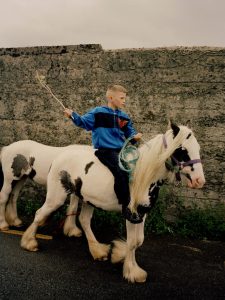
Solo, a collector of photo-poetry publications, adds that the earliest example he encountered is a French pamphlet from the 1850s. In these initial forays, he explains, the photography tended to be illustrative and used instead of engravings, so you might have a poem by Robert Burns alongside an image of castle ruins in Scottish landscape. The early 20th century avant-garde Dada and Surrealist movements precipitated a more experimental evolution, of which “the iconic example is Man Ray and Paul Éluard’s Facile [1935],” he says. Latin America has a strong tradition of photo-poetry, from the 1954 Alturas de Macchu Picchu with poems by Pablo Neruda and photographs by Martín Chambi to the current output of contemporary Buenos Aires-based photobook publishers La Luminosa Editorial, which frequently combines text with image.
Many established poets have explored one- off photographic partnerships – such as Ted Hughes with Fay Godwin or Seamus Heaney with Rachel Giese – but generally these alliances drift in and out of vogue. “These collaborations work best when the poetry is not a caption and the photography is not an illustration, but rather both raise questions. The less literal the relationship, the more successful,” says Solo. He adds that the 1960s and 70s proved another fertile phase, and agrees that we are seeing a resurgence again today. Instagram may be a factor, having brought poetry and photography to wider audiences. And, despite exponential digitalisation, the 21st century has also seen a flourishing of independently published print books and zines. But what, in particular, attracts photographers to poetry?
Perhaps it is down to what they share – finite parameters, a heightened view of the world. “Poetry is good at elevating the everyday or looking at ordinary things in a new light and that is what my pictures do. I’m not a classic documentary photographer,” Johny Pitts explains over a video call from Bern, where he is currently guest professor at the university. Pitts was already friends with the writer Roger Robinson and they were keen to team up; in the wake of George Floyd’s murder, their planned collaboration took on a new urgency. “But let’s not react too much to the current moment,” Pitts decided. “Let’s do something unexpected, something we would probably never have been able to do before.” That was the genesis of Home is Not a Place – a book and exhibition uniting Pitts’ images with Robinson’s poems.
Unlike with Hicks and Berry, here the images do not always spark the poems. While the book includes some archive photographs Pitts had amassed over the past decade and a half, it also features new ones produced during a road trip the duo undertook around the coast of the UK – an approach similar to that which Seamus Murphy and PJ Harvey followed between 2011 and 2014 when they travelled together to Kosovo, Afghanistan and Washington, DC, and “Harvey collected words and Murphy collected pictures”. Influenced by Paul Gilroy’s notion of “the Black Atlantic”, Pitts and Robinson wanted to look beyond London, remapping Britain through Black histories of arrival, displacement, change. “What you’re trying to do as a photographer and as a poet, is to work with ghosts, trying to capture things that aren’t actually there,” Pitts says.
The process varied. Sometimes they would respond concurrently to the same moment in their own artistic languages. Other times, images and words would find each other retrospectively, through editing and sequencing. Although it was completely different in form, Pitts was conscious of The Sweet Flypaper of Life, a 1955 portrait of Harlem with images by Roy DeCarava interspersed with words by Langston Hughes, which stitch the photographs together, breathing life into them via a fictional narrative. The book’s form, design and layout are closely bound up with how the images and photographs are produced and then read in relation to each other.
Photojournalist Anastasia Taylor-Lind, who completed an MA at The Poetry School in October 2023 and published her debut collection, One Language, in 2022, makes a similar point, offering some volumes as examples: Caleb Femi’s Poor is the compact size you would expect of a poetry book, with photographs by the author appearing throughout, while the larger Home is Not a Place looks and feels more like a photobook. Taylor-Lind’s book is led by poetry, though it includes images, and her verses allude to a photographic view of the world – a “soft-box dawn”, for example. “This craft of intricate observation is a skill I have developed as a photographer,” she says, adding that both are practices rooted in extraction, removing anything superfluous until only essence remains, each frame or word weighed out.




